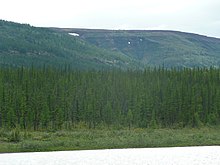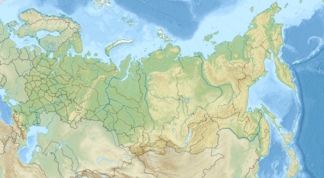Putorana Mountains
| Putorana Mountains / Putorana Plateau | ||
|---|---|---|
|
Plateau mountain of the Putorana Mountains |
||
| Highest peak | Kamen ( 1701 m ) | |
| location |
Krasnoyarsk Region , Russia ( Asia ) |
|
| part of | Central Siberian mountain country | |
|
|
||
| Coordinates | 69 ° 0 ′ N , 93 ° 0 ′ E | |
| particularities | UNESCO - World Natural Heritage (2010) | |


The putorana plateau ( Russian Горы Путорана ), in particular its core area is due to the plateau-like mountains also Putorana plateau called (Плато Путорана), is one to 1701 m high mountains of the central Siberian highlands , both in the north of Siberia , the Krasnoyarsk Territory and Russia ( Asia ) located. The geographical center of Russia lies in the mountains on the Wiwisee .
geography
location
The Putorana Mountains are located in the frame with their highest region around 300 km north of the Arctic Circle . It forms the very large north-western part of the Central Siberian mountainous region. To the north, its mountainous landscape descends into the Taimyr Depression , the central part of the North Siberian Lowland , to the east it leads to the Anabar Plateau and to the southeast to the Wiljuiplateau , to the west it partly falls over the Lontokoiski-Kamen Mountains into the extensive West Siberian lowland , in which especially the river basins of Yenisei and Ob lie, and over their southern foothills Sywermaplateau into the valley of the Lower Tunguska .
Between the northern Taimyr Depression and its outer southern foothills, the Lower Tunguska, the mountain range is around 750 km (approx. 71 ° to 64 ° N ) and between the rivers Pjassina in the west and Kotui in the east around 550 km (approx. 88 ° to 101 ° E ) Expansion. Its core area, the Putorana Plateau , is much smaller at around 175 by 175 km.
Mountains, glaciers and bodies of water
The highest mountain in the Putorana Mountains is Kamen ( 1701 m ), near the source of the Kotui River . In the north-east and east of the mountains there are a few small glaciers with a total area of only 2.5 km².
The mountains are sometimes referred to as the "land of ten thousand lakes and a thousand waterfalls". The rivers, which mostly run in gorges in the mountains and form many rapids and waterfalls, include Chantaika , Cheta , Embentschime , Kochetschum , Kotui , Kureika , Maimetscha , Pyassina , Severnaya , Tembentschi , Tutontschana and Wiwi ; the lower Tunguska , which is fed by some of the aforementioned rivers, passes the outer southern foothills of the mountains , and the Norilka flows past the north-western foothills . There are also many lakes and reservoirs within or at the edge of the mountain, are the largest: Agatasee , Ajansee , Chantaikastausee , Chantaisee , Lake Dyupkun on Kotui, Lake Dyupkun at the Kureika, lake glubokoye , Lake Keta (Kemasee) Kutaramakansee , Kureikastausee , Lake Lama , Melkojesee , Nakomjakensee , Pjassinosee , Sobatschjesee and Wiwisee . Some of these maximally 150 km long and up to 420 m deep lakes have a cryptodepression within their lake basin ; for example, the depth of most lakes in the western part of the mountains is between 50 and 300 m below sea level . These deep lake basins were created by tectonic movements. On the left bank of the Djupkunsee on the Kureika is the Talnikowy waterfall , which at 482 m is one of the highest waterfalls on earth .
Localities and Industry
There are no large settlements in the extensive Putorana Mountains. However, Norilsk is the only city near its western foothills , the northeastern part of which Talnach is located directly on the western slope of the mountains.
geology
From a geological point of view, the Putorana Mountains are almost entirely made up of basalts and related rocks that belong to the volcanism of the Siberian Trapp . There are large deposits of ore , copper and nickel in the northwest . The northern and western slopes of the mostly plateau-like mountains have mostly steep slopes with a maximum difference in altitude of 800 m (in some places even more), the eastern and southern slopes mostly drop gently. In many places the landscape is rugged and - typical of frost rubble deserts - heavily weathered. In 1980 the mineral putoranite named after him was discovered near Talnach on the north-western edge of the mountain range .
climate
In the Putorana Mountains, apart from some valley locations (like Lake Lama ), which are less exposed to cold north winds, there is a harsh continental climate . In winter the thermometer falls to an average of −27.5 ° C in January and in summer it rises to an average of +14.2 ° C in the valley areas in July. The average annual rainfall is 453 mm. Most precipitation falls with 57 mm in August, the minimum with 24 mm in February. In the winters with little precipitation, only a small amount of snow usually forms, which is then retained for 8 months. As a result of climate change, the permafrost soil is increasingly thawing and therefore becoming muddy. In the mountains, the polar day lasts from May 16 to July 29 (75 days) and the polar night from November 25 to January 13 (50 days).
Flora and fauna
Boreal coniferous forest (taiga with spruce and larch ) spreads in the valleys of the Putorana Mountains , and on the rocky plateaus the tundra is covered with lichens and mosses .
The mountains are crossed every year by the largest wild reindeer herd on earth. Around 500,000 wild reindeer migrate through the area and spend around five to six months here each year. A specialty is the Putorana snow sheep ( Ovis nivicola borealis ), a geographically isolated subspecies of the snow sheep, which separated from its conspecifics in the main range to the east 15,000 years ago. Other large animals of the Putorana Mountains are elk , wolf , brown bear , Eurasian lynx and wolverine . Small and medium-sized mammals in the region are red fox , arctic fox , otter , ermine , sable , European flying squirrel , squirrel , Siberian chipmunk , wood lemming , Siberian lemming , collar lemming , muskrat , northern pigeon hare , and mountain hare . Noticeable bird of prey species are golden eagles , white-tailed eagles , ospreys , peregrine falcons , gyr falcons and merlins . Owls are about by hawk owl , great gray owl and Ural represented. Among the hens are capercaillie , stone capercaillie and hazel grouse . Numerous water bird species inhabit the region's waters. Including about yellow-billed loon , Gray-tailed tattler , Little Curlew , Lesser White , Red-breasted Goose and Tundra Swan . It is unclear whether the black crane is present. The only representative of the amphibians is the Siberian angular newt . The rivers are rich in fish , especially salmon fish such as taimen , arctic grayling , omul , lenok and char . The burbot and a loach species ( Acanthocobitis urophthalamus ) do not count as salmon fish .
Research and protection status
The Putorana Mountains were first researched and scientifically described by the German-Baltic explorer and zoologist Alexander Theodor von Middendorff (1815–1894).
The mountains in which the Putorana State Nature Reserve (18,872.51 km²), founded in 1988, is located, was declared a World Heritage Site by UNESCO in 2010 . The reserve protects almost a third of the area where the Putorana snow sheep can be found. The population of these wild sheep was around 3500 animals here in the 1980s, and the trend is increasing. In addition, the typical species of the Putorana Mountains occur in the reserve. A total of at least 38 mammal, 140 bird and 36 fish species live here.

environmental pollution
The industrial assets of the Group MMC Norilsk Nickel , the world leader in the production of nickel and palladium , with the northwestern foothills of Putorana Mountains in Talnach and on the nearby Lontokoiski-Kamen Mountains in Norilsk and Kayerkan located mines , lead to severe environmental pollution . Therefore, the mountains, especially in the northwest, are heavily polluted with heavy metals and various environmental toxins.
Individual evidence
- ↑ a b c d e Information on the Putorana Mountains ( Memento from December 20, 2010 in the Internet Archive ), on tvsh2004.narod.ru (Russian)
- ^ A b United Nations Environment Program & World Conservation Monitoring Center: The Putorana Plateau, Russian Federation. World Heritage Sites. June 2010, on unesco.org
- ↑ Project profile World Heritage Program Russia ( Memento of the original from September 18, 2010 in the Internet Archive ) Info: The archive link was inserted automatically and has not yet been checked. Please check the original and archive link according to the instructions and then remove this notice. , at the Federal Agency for Nature Conservation, on bfn.de
Web links
- Photos of the Putorana Mountains on tourism.intat.ru (Russian)






